|
Sherborne House
its character and history
The short main street of Lyme Regis climbs steeply from the sea,
and near the top on the right is a blue door that excites curiosity.
It's down a couple of steps, and is recessed under a white entablature
on which “Sherborne House” is painted in elegant letters.
\U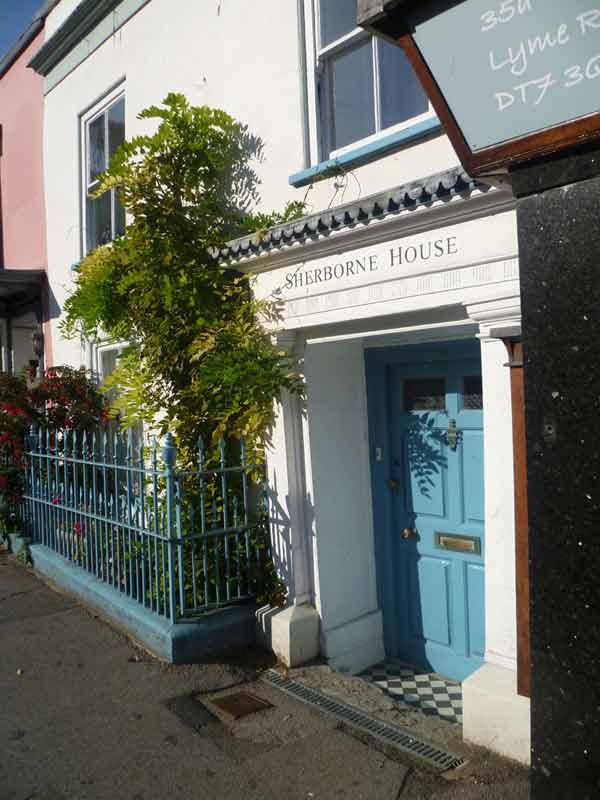
This is the only
residence that opens directly onto the historic street. (Others
are up stairs beside shops, or are reached along passages.) Therefore
the ground-floor window is protected by an iron railing, of the
same pleasing shade of shiny light blue, and this encloses a small
area containing flowers and a wisteria that copiously frames the
door, a. This vegetation, also, is unique on the street
There are shops
on either side, that on the left being at the very top of the street,
on the corner of Sherborne Lane. But if you step back you can see
that these must formerly have been parts of Sherborne House. The
threefold unit has one roof and one façade, unified by a symmetrical
cornice across the top, along which stands an array of classical
urns. The roofline, though at the top of the steep street, is lower
than those of the other buildings around, all of which are of three
storeys and are newer.
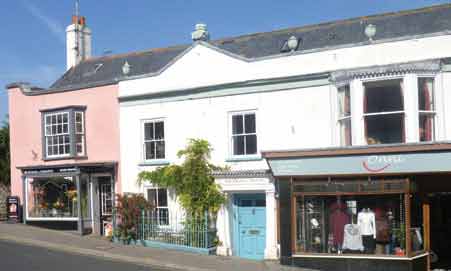
This evidently was
once a “gentleman's house” in 18th-century style, probably
with grounds extending down Sherborne Lane from which it got its
name (a name going back to the earliest record of Lyme, in the 8th
century). But it has been complicated by a series of changes, some
of which you can already see. Not only did the left and right parts
of the ground floor become shops, but with the left part went the
storey above it, and that whole left part is now painted pink, as
if deliberately to break up the unity. Thus Sherborne House became
separated from Sherborne Lane.
What it's like inside
Entering through the blue door, you
find yourself not in a reception room such as the mansion once had,
but in a humble passage more suggestive of a farmhouse. There is
light at the other end from a glazed garden door. There
is a diamond-checkerboard tiled floor, some exposed masonry, roughened
ancient beams, two doors to rooms on the left, and between them
a carpeted stair.
Go up this rather short stair and you may be uncertain which way to turn; there are several doors around. Doubling back along a landing, you burst into the main room, 23 feet long and (irregularly) about 16 wide.
This exemplifies
a principle used in houses designed by the American architect Frank
Lloyd Wright: if you are made to enter by way of confined passages,
emergence into a sudden large interior is all the more impressive.
The room's pine
floor has plenty of space for rugs and couches, but the space is
varied by features that include beams, a projecting wall, and a
masonry wall containing two large hearths side by side. The end
wall, 16 by 8 feet, is covered by the house's largest (though by
no means only) set of bookshelves. One of the windows is a wide
bay overlooking the street.
Visitors to the
house sometimes get a little lost on the way out! To live
in it is to continue to relish its surprises.
The window bay is
filled by a knee-height dais, so that, strewn with cushions, it
is a bower. And it is a grandstand for the Lyme Regis pageantry
that so often takes place immediately below — the jazz festival, lifeboat week, carnival and regatta week, the fossil festival, the food festival, the folk music weekend, Candles on the Cobb, Guitars on the Beach, the 1644 siege re-enactment, the Sir George Somers of Bermuda parade, the runner with the Olympic torch, the Good Friday procession, the Easter and Christmas parades. Many of these assemble in the forecourt of the cinema, at eye level just opposite here, and march off down the street.
Those two large
hearths side by side, what is the reason for them? There once was
a main fireplace in the room below, and the chimney flue rose straight
up from it. Therefore the fireplace in this upper room had to be
displaced into the room's corner, and its own tributary flue sloped
leftward to join the main one. After the fireplace below disappeared,
a new one could be opened vertically above it, more centrally for
the room. The side flue is blocked, but its hearth has been re-opened
to display the history, and serves as a cave in which wood can be
stored.
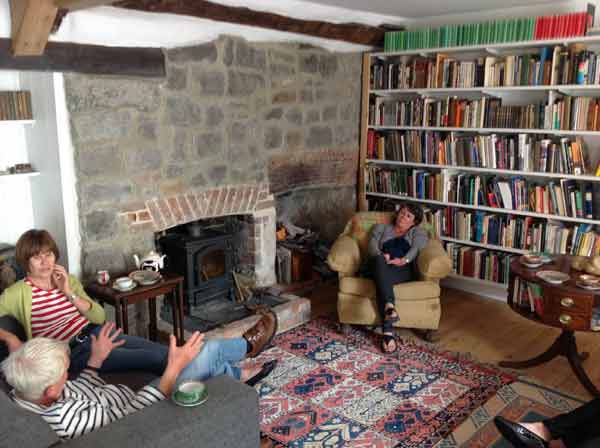
(Around in the kitchen
there is a wood-lined storage cubby-hole at head height. It is a
recent utilisation of just a small part of the irregular space left
inside the chimney mass, an air-space which reaches into the next
building down the street.)
The house contained
at least four other fireplaces: in the kitchen and the bedroom,
in the utility room, and across a corner of the downstairs room
(its brickwork showing beside the front door). But of these, the
first has only a brick stub of a chimney above it, the second a
flue that is blocked inside the wall, the third has disappeared
entirely, and only the last is still usable. And if you light a
fire in it, where does the smoke go, since only one brick chimneystack
survives above the roof? Go into the street and see. The smoke emerges
from one of those ornamental urns!
Yet other fireplaces
were in the rooms that are now the two shops. The left-hand one
survives as a bay inside the shop, and its massive chimneybreast
projects into Sherborne Lane, narrowing the upper end of the lane
to seven feet.
The front wall of
the house is more than twenty inches thick, as can be seen from
the wide sills of the wood-shuttered windows piercing it. Surfaces
of masonry exposed in the downstairs passage, the bedroom and the
living room, and other surfaces plastered, are segments of an even
thicker wall (parts of which, amazingly, are now supported on concealed
steel beams). This wall was once the back of the house, showing
that rooms have been added beyond it.
The house has the
feeling of being knitted into the fabric of the old town. The bedroom
and utility room share a block with what is behind the left-hand
shop. The kitchen is above the rear extension of the right-hand
shop, and one of the outbuildings along the side of the garden belongs
to the shop, the other to the house. From just outside the back
door, a window in a projecting corner of that shop gives a glimpse
all through the shop to the street.
Because of the way
the house has grown — beside a sloping street and in pieces
behind and over each other — every room is on a different
level. (Only one is level with the downstairs passage, and only
one with the upstairs landing.) So there are many steps. Three openings
are grouped at a corner of the living room (two of them through
one gap in the thick wall): up two steps to the landing; down one
angled step to the bathroom; up four steps that twist through a
connecting piece to the kitchen.
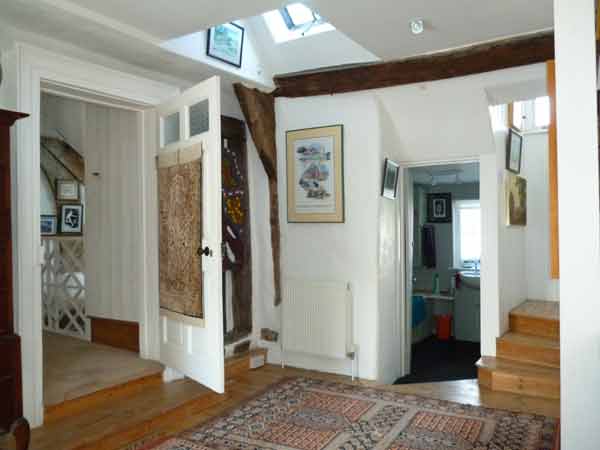
Some of the rooms
are fairly low-ceilinged (hence the shortness of the stairway).
But the large kitchen and bedroom rise to their roofs in pyramidal
spaces, crossed by beams of which some are free and some embedded
in the plaster.
Skylights have been
opened at half a dozen interesting points in the roofs. Through
the one in the bedroom, moonlight floods and stars are glimpsed.
(Even though the
bedroom is on the quiet northern side of the house, the view from
it through this skylight is to the south: that is, high on the meridian,
so that the winter full moon appears in it at midnight, as do stars
in their seasons — Vega in June, Capella in December — and
planets when at their nearest and brightest, such as Jupiter at
its opposition in October 2011. A point of interest to skylovers!)
The bathroom, one
of the additions at the back, is made light by a triangular window-projection,
providing a useful sill and looking into the garden.
From the bedroom
window you may feel that you are overlooked by other buildings close
around — then you realize that they are all parts of this house!
The bedroom is adjacent
to the bathroom in that they share a section of wall, yet the route
from one to the other is quite lengthy, wrapping around a fireplace,
the stair, and another door that you may not at first have noticed.
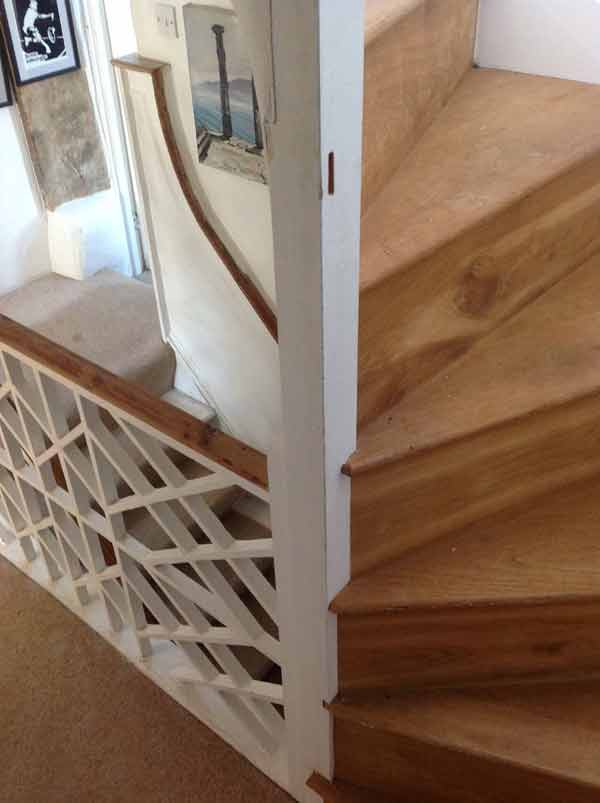 This is a plain
latched wooden door beside the landing, next to a white surface
that rises over the stairway in a smoothly twisted curve. The surface
envelops the underside of nine pinewood steps that spiral tightly
to the attic. They would not be able to do so but that a space has
been made for them by adding a dormer window in the roof. This is a plain
latched wooden door beside the landing, next to a white surface
that rises over the stairway in a smoothly twisted curve. The surface
envelops the underside of nine pinewood steps that spiral tightly
to the attic. They would not be able to do so but that a space has
been made for them by adding a dormer window in the roof.
The attic room has
a floor of the same blond pinewood. A step up, under a massive pair
of beams, leads into a second part of the attic room, lighted by
two facing skylights. And at the end of it is a hatchway closed
with a heavy removable piece of wood, a sort of pentagonal shield.
The opening has to be small because it is surrounded by ancient
beams, and it is the only way of scrambling into a rather mysterious
third region of the attic, almost like a priest-hole, dark and almost
unusable because it has no floor.
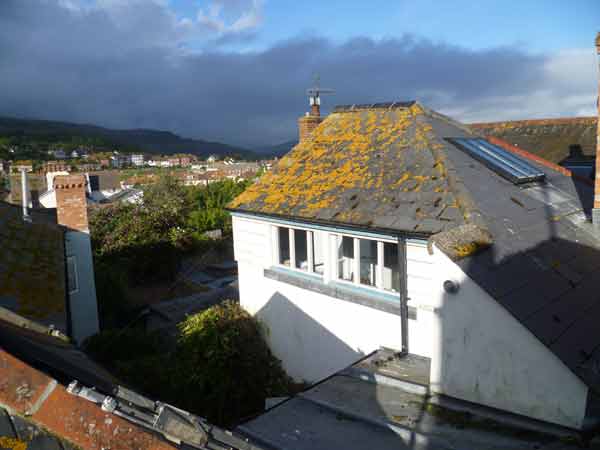
From the dormer
window you look out on a lichen-dappled roofscape of which the nearer
elements — half of the pyramidal roof to the left, higher roof
to the right, and flat lead roof below — are parts of this house.
The next nearest roofs are of the cottages running down Sherborne
Lane, and the highest roof, to the left, is that of the former manse
of the Baptist church at the top of Sherborne Lane. The view is
down the garden and across the river-valley part of the town and
up to the cliffs and skyline of Timber Hill. You can even get out
of this window and explore the valleys between the roofs, looking
down through skylights into points inside the house. And from the
dormer and the attic skylights you can observe the family life of
the gulls that regard this as their territory in nesting season.
(To them it is a landscape of rocks under which there happen to
be caves inhabited by apes.) It is prime gull real estate because
a chick that falls out of the nest will fall safely to a roof valley.
Perhaps most interesting
of all are the various beams we have mentioned. The materials added
to hide them have been removed so as to reveal the rough markings
of their history. The uprights and horizontals in the downstairs
passage and in the living room belong to old partition walls. The
skeleton of the house consisted of several cruck frames, enormous
jointed timbers that bent inward to meet under the roof ridge. One
is exposed only in the landing next to the bedroom door. Another
is glimpsed in two high corners of the living room; its upper parts
meet to form the arch that divides the attic. Here the nature of
the cruck can be most clearly seen: the timbers are narrow in relation
to their vertical width, this giving them strength; but they have
been repaired perhaps centuries ago with iron ties and some cement.
Of the next cruck, two fragments are hidden in triangular casings
of modern wood half way along the living room, beside a modern straight
beam; above, these timbers continue as part of the surround to the
hatchway into the remote region of the attic, and can be seen only
when you clamber through that hatchway.
Also visible in
parts are the ridge purlin (seen in the ceiling of the attic), other
horizontal purlins, and collar ties and cruck ties (joining the
sides of each cruck, respectively above and below the level of the
attic floor). Many of these ties have been removed to make head-room,
but some of the holes for the pegs by which they were attached to
the crucks are visible. The collar tie under the hatchway is “banana-shaped,”
a timber selected for its upward curvature.
Some of these timbers
show the holes of woodworms (long exterminated), yet have become
so hard that a hand-driven screw cannot penetrate them. Most probably
date back to the founding of the house in the 1400s. And they may,
as happened with other houses in this seaport, have been re-used
ship timbers; which could have been from oaks growing a thousand
years ago.
History,
based initially on notes written by David Highet “on the train
to Durham”
Probably (a word
that must be applied to much of the rest of what we say) a single
two-storey house stood on this site from the 15th century or possibly
earlier; it covered the ground of what are now 34 and 35 Broad Street.
The outside walls were of solid lias masonry, and a series of timber-jointed
cruck frames supported the roof, which will have been thatched.
(A dendrochronological study of a similar cruck in Coombe Street — that is, a matching of the growth rings in a sample of the wood to known patterns in other wood so as to fix the year in which the tree was cut — found a date of 1492 — the year when Columbus crossed the Atlantic. Such a study could fix the age of the Sherborne House timbers.)
Thus this house is among the oldest, if not the oldest, in the street, a rare survival. Many others succumbed to unstable foundations or to the several fires that swept the town.
It's been suggested that this house, built at the upper end of the street and at what was then the northwestern edge of the tiny medieval town, could have been a farmhouse, like those at the southern edge of old Axminster. and that it may have had orchards reaching down to the river; in other words, the farm's sloping territory may have included all that is now covered by the houses down along Sherborne Lane and along the southern bank of the river toward the mill. The Sherborne Lane cottages could have started as dwellings for the farm labourers. However, the Woodmead farm was not far out from here, and Lyme was not an agricultural community like Axminster but a fishing and trading port; the house perhaps belonged to a merchant or craftsman.
The single front
door opened into a cross passage (sometimes called a lace passage)
through to the back — a common late-medieval ground plan. The
passage had on each side a plank-and-muntin screen, that is, a partition
wall composed of boards about a foot wide slotted into beveled vertical
studs almost as wide and into a head beam above. Of the screen on
the right there remains only a long head member; on the left, two
sections, but only two of the muntins, and the plank between them,
are original. On the plank can be discerned a faint white chalk
scrawl that could be a carpenter's mark, preserved by being later
covered. The other uprights, narrower and rough, are pieces of wood
re-used from somewhere else; the nine-inch mortise cut into one
of them cannot have had anything fitted into it in its present situation.
There are examples of plank-and-muntin screens at Dalwood and other
places in Devon and Dorset.
The main reception
room will have been to the right of the passage, where the right-hand
shop now is; clearly seen is the blocked former doorway, with a
moulded frame of a later period. The floor above the main room was
supported by oak stop-chamfered beams, which are still in place
though hidden by the shop's suspended ceiling. (A “chamfer”
is a bevel along the edge of a piece of wood; it is “stopped”
if it ends before the corner; and there are several styles both
of chamfering and of stopping.)
There will have
been a ground-floor fireplace in the room's rear wall. The fireplace
in the room above (the present living room) had to be in that room's
corner, because it could not be above the other one. Over this upper
fireplace was an oak beam, stop-chamfered and slightly arch-shaped.
The reveals (inner surfaces) of the fireplace were made of Beer
Stone, which shows chisel marks possibly for holding render onto
it when the fireplace was no longer in use.
(Beer Stone is a
prized Cretaceous limestone from the ancient quarry above Beer, a few miles away in Devon; fine-grained so that it could be sawn in any direction, fairly soft for carving when mined but hardening with exposure, it was favoured for ecclesiastical features such as doors and windows, for example in Exeter Cathedral, as well as St. Paul's Cathedral, Westminster Abbey, and London Bridge. The quarry was used from Roman times to the 1920s, became a system of artificial caves, has also been a secret Catholic church, a smugglers' storehouse, and a mushroom farm.)
The crucks would have been pre-assembled, raised, and then set on a masonry base about a yard high, the rest of the outside wall then being built up around them.
Wallplates —
horizontal beams on which the roof rested — would have lain
along the tops of the masonry walls. A short piece of one can be
seen in the front wall of the living room, with fourteen inches
of masonry above it, showing that the height of the wall was later
increased.
Also from this first
phase are the timbers of the screen wall along the northwest side
of the living room.
The gable end of
the house on the southeast or down-street side was a jettied wall.
That is, each floor stuck out some inches farther than the one below
it, so that rainwater running down would fall clear. This three-tiered
wall was surfaced on the outside with weathered-lime render over
straw. Jettied walls like this can be seen for instance in the old
town of Tewkesbury. That this was clearly an outside wall is evidence
that there was originally no building immediatelyadjacent, or at least a gap. Indeed, the present No. 36 is later, dating from the 18th century. There is still a hidden airspace.
At the rear, behind
what is now the right-hand shop, there was a lean-to extension with
a “cat-slide roof” sloping down away from the house (later
to be replaced by the taller present extension).
On the Sherborne
Lane side, a two-storey addition was made at the rear, nearly half
as wide as the house and joining to the first of the cottages down
the lane. This addition may have antedated and led to the cottages;
another suggestion is that it was later, filling in a space that
would have been a gap through to the lane, so that the owner of
the house could have kept a coach in the back yard and driven it
through to the lane and thus out into the street. At any rate, the
addition was probably a servants' wing, with kitchen and dairy downstairs.
(It is the section now consisting of utility room downstairs and
bedroom above, with narrower passages on the Sherborne Lane side.)
From Sherborne Lane it can be seen that a narrow window goes up
through both levels, presumably meaning that it opened onto a staircase.
There was formerly a fireplace in the lower level of the addition
(in the part of the utility room now forming a closet), sharing
a chimney with the fireplace preserved in the bedroom above. The
room above (presumably then as now a bedroom) had a ceiling made
of long stiff reeds.
Around the end of the 18th century, the house underwent major adaptation
and upgrading — a gentrification.
It got a new slated roof, set higher
than the original. Along the front of this was added a parapet,
symmetrical about a central peak, and with a “dentil and moulded”
cornice. This parapet was topped by a row of urns. Of these there
must have been seven; the two at the Sherborne Lane end, not over
the present house, have disappeared (fallen or stolen?). The urns
are of Coade Stone.
(Eleanor Coade, inventor of Coade Stone, inherited from her mother a factory in London where the Royal Festival Hall now stands — one of her millstones is displayed there beside the footpath under Hungerford Bridge. But from 1784 to her death in 1821 she lived at Lyme, in Belmont House, which had been her uncle's and later belonged to the novelist John Fowles, at the junction of Pound Street and Cobb Road. According to Roberts's History of Lyme, 1834, p. 251 and 253, coad was a dialect word for “unhealthy,” and “Coade, the name of an old family, is pronounced as if spelt Cwerd.” Eleanor was known as “Mrs. Coade” but never married. Her material, which she called Lithodipyra, “stone twice fired,” consisted of 10% grog, 5-10% crushed flint, 5-10% fine quartz, 10% crushed soda lime glass, and 60-70% Ball clay from Dorset and Devon, kneaded and then fired for four days in a kiln at 1,000°C. This formula was not “secret,” as rumour had it, but nobody else managed it so successfully. It was famous for being easily mouldable into shapes, like sculpture, yet incredibly resistant to decay even in London's corrosively polluted atmosphere. It was popular until the 1840s. The only examples in Lyme are the dolphin and Neptune sculptures on the façade of Belmont House itself, the paving including ammonites in front of the Lyme Regis museum, and the Sherborne House urns, whose surface has unfortunately been concealed by paint. Others are the lion on Westminster Bridge, the frontispiece of Twinings on the Strand, the Nelson Pediment at the Greenwich Royal Naval College, the crest on the Imperial War Museum, ornaments at the back of Buckingham Palace and at St. Paul's Cathedral and the Brighton Pavilion, and the entrance to the Rio de Janeiro zoo — altogether “over 650” according to one source.)
The central urn,
set higher and with more elaborate form, was a disguised chimney
pot. It capped a flue that was gouged all the way down the interior
side of the masonry wall — a daunting project — to the fireplace
that was now added to the small ground-floor front room, the room
that is like a “parson's study” and is now my study.
Where originally was the staircase?
Perhaps somewhere in what is now the eastern shop. The drastic hacking-away
of the beam above the present stair shows that the older opening
here, if any, must have been cut higher so that the stair could
be inserted; it still is barely high enough to avoid bumped heads.
The treads of the thirteen steps were only nine inches wide —
shorter than most people's feet — so, later, they were extended
by having one-and-a-half inch strips screwed to their fronts; these
project farther than the stringers (boards sloping down the stair's
sides), so the added pieces were bevelled off at their ends. (These
details are now hidden by carpeting.)
The space occupied by the staircase
may previously have been a narrow ground-floor storeroom. The lower
part of it remaining as a closet off the front room, from which
it is divided by a rough plank wall (masked at the front by plaster).
The new stair, ascending into a space
that could earlier have been a workshop, is flanked by moulded panels
and hand-rails. The landing balustrade is in the “Chinese Chippendale”
design of interlocking diagonal struts. Balustrades of this kind
were fashionable in the late 18th century; a conspicuous example
is on the roof of Thomas Jefferson's Palladian house Monticello
in Virginia.
In accordance with
Georgian fashion, sash windows with small panes and shutters were
inserted, and panelled doors with moulded doorframes.
Whereas the main
living room had been downstairs, the room above it must now have
become important, so it had to have a fireplace, and this had to
be inserted into its corner, with a new diagonal brick flue connecting
it to the vertical chimney. This room and others were remodeled
so that, conforming to Georgian taste, they were painted “boxes,”
with no visible beams or stonework. Some of the cruck ties were
covered, others removed to make more space.
And it was possibly
now that the iron railing, with spears of alternating heights, was
added on the street front. (The house is a Listed Building, Grade
Two, and the railing is a separately Listed structure, also with
Grade Two status, along with such monuments as the town church!)
Then came “trade.”
The left and right
thirds of the lower level became two shops (so that the house itself
became T-shaped, rather like the wisteria that now embellishes its
front). This seems to have happened first with the one on the left.
The numbering of the properties — 34 for the left-hand shop,
35 for the rest — was presumably done when the right-hand portion
either had not yet become a shop, or was in the same ownership as
the house. Only after this stage will the doorway from the house's
entrance passage into the right-hand room have been blocked. It
is hard to tell where the openings were between the present house
and its former rooms to the left. One would think that the name
"Sherborne House" was given before the part actually touching Sherborne
Lane was alienated from it; but such house names are not necessarily
old.
Projecting shop
windows were added below the bay windows of the left and right parts
of the upper level. The stylistic age was still early-Georgian;
the shop window on the left survives in its original form, and a
drawing by Beatrix Potter in the Lyme Regis museum shows the same
frontage for the right-hand shop.
About 1850-60 the
two-storey wing at the rear of the right-hand shop was added, with
timber frame and external render. The ground floor had, in Victorian
style, higher ceilings than the front shop, necessitating on the
level above the four steps twsting up between what are now the living
room and the kitchen.
Between 1890 and
1910, the street frontage was altered to its current appearance.
The two shops received enlarged single-pane fronts. Whereas the
sash window of the room over the left-hand shop retains the six-over-six
arrangement of panes, that of the living room over the right-hand
shop was simplified to one-over-one. The right-hand shop got a door
of mahogany from colonial South Africa. That shop's decorative art-nouveau
wall tiles, and the ceramic floors here and in the house's entrance
passage, date from this time.
The left-hand shop
was probably a bakery, extending back through the row of three or
four cottages on Sherborne Lane: evidence is that the end cottage
has a ceiling supported by steel girders rather than wooden beams,
to bear the weight of flour sacks stored above, and traces in the
upper wall of a delivery door through which these sacks would have
been hoisted up from the lane.
The right-hand shop was a butcher's
(Tuffin). It had, in addition to the house's right-hand front room,
a room that is now the house's utility room, and therefore to connect
to it the rear part of the central passage, by the back door; also
the yard behind; and, at the end of it, a small building fifty yards
down Sherborne Lane, then used just as a garage. The narrow upper
part of the yard, between the buildings, was used for slaughtering
and was paved with concrete. Down the right-hand side of it was
a series of outhouses of diminishing size, ending with a coal-bunker.
The Broad Street bus stop was just outside the butcher shop, and
local people recall that, as there was no bus shelter, the butcher
allowed them to wait inside his shop; which was good for his business.
The residential
house itself was left with the small central front downstairs room,
the passage back as far as the opening (then blocked) in the thick
stone wall, the stair, and the central and right-hand parts of the
upper floor. The former downstairs main room having been ceded to
the butcher shop, the fireplace in it had disappeared; so, in the
living room above, a new fireplace could be opened in the central
position. Its arch was formed of two blocks of Ham Stone which may
originally have been coping stones from walls. The corner fireplace
became disused.
The left-hand shop became a restaurant,
called The Mad Hatter, which flourished for several decades. Still
joined to it were the first several cottages of the row that had
reached down Sherborne Lane. From the attractively situated front
room at the top corner of Broad Street, with its window bay below
the level of the street corner, you could go down a succession of
steps past the restaurant's other booths, each with irregular shape
caused by its history, and each clearly the ground level of one
of the former cottages; the last was the restaurant's kitchen. And
it was not unknown for coffee to be served through the kitchen window
to residents of the house in their garden. The level above was a
holiday flat. The restaurant and flat above were taken over by a
new owner, and in 2010 the restaurant was closed and replaced by
a flower shop. This did not need the auxiliary rooms and the kitchen,
and so was cut off from this interesting succession of former cottage
rooms. They disappeared into a new arrangement of two cottages (each
with bedroom downstairs and living room upstairs, one of these being
the room above the flower shop.
The house itself
went through a period of neglect. From about 1930 it was the office
of the accountants Lentells (now out in the office park on the site
of the former railway station). The small downstairs front room
was for reception, the boss's office was in what is now the kitchen
and another office in what is now the bedroom; what is now the living
room was made smaller by partition walls, one corner of it (next
to the present bathroom) being the lavatory. Beams and stonework
were covered throughout with woodchip, which was painted pink, and
much space was occupied by filing cabinets. The side-by-side fireplaces
in the main room had both been filled with rubble and hidden.
In 2000 David and
Hilary Highet took over the right-hand shop (which became Hilary's
dress shop), the butcher's garage down the lane (which they remodelled
and enlarged into an attractive cottage), and the house itself,
consisting of the former butcher premises on the ground level and
all of the upper level except that over the left-hand shop. (Thus
35 Broad Stree, containing a dwelling and a shop, became what the
government designates as a “Composite Hereditament.”)
David, an architect,
with the help of his brother Chris, revealed and enhanced the house's
character. Between 2002 and 2005 the Highets had the spear railing
repaired by a local craftsman; removed woodchip coverings to expose
as much as possible of the ancient stone and timber; removed the
kitchen ceiling and the bedroom's reed ceiling to let the rafters
show; opened a door into the bedroom instead of what had been a
small devious passage through what is now the closet; removed partition
walls to create a living room even larger than the old one may have
been; added the several skylights and the projecting bathroom window;
reworked other features; and supported several parts of the structure
with concealed steel beams. They discovered and unblocked both of
the fireplaces in the living room, removing from the central one
the two Ham Stone blocks (one of which is now in the garden) and
replacing them with a brick arch. They discovered the air space
(and thin partition wall) between the house and No. 36 and added
a better wall with sound-proofing; and in the course of this had
to move along and shorten the beam over the oldest fireplace. In
the yard, they converted the ending part of the series of out-buildings
into a garden studio.
At this stage the
property surrounded the corner buildings of Sherborne Lane (the
Mad Hatter and holiday flats), opening onto the lane as well as
onto Broad Street, and the garden behind Sherborne House connected
through a gate into the yard opening onto Sherborne Lane. The upper
and narrow part of the garden between the rear wings, concreted
over by the butcher, was covered over with gravel and stepping-stones,
and four arbours supporting honeysuckles, which filled the space
with greenery and grew far up the walls. Since fumes from the Mad
Hatter's kitchen emerged in the garden, the Highets had a chimney
built for them, projecting into the garden.
In 2009 Guy Ottewell
and Tilly Lavenás came to live in Sherborne House (the cottage and
yard on Sherborne Lane and the right-hand shop on Broad Street being
retained by the Highets). Guy and Tilly remodelled the garden in
2011.
The slightly wider setting
Around the corner in Sherborne Lane, a plaque tells you that
IN 774 KING CYNEWULF OF WESSEX GRANTED A MANOR ON THE WEST BANK OF THE LIM TO SHERBORNE ABBEY. THIS STREET GOES BACK TO SAXON TIMES.
It is the earliest documented fact in Lyme's history. The monks of Sherborne in north Dorset received rights to pan salt from the sea, and a “manor” of land on which some of them came to live. Probably their path from their quarters (by the river) to their salt pans (by the then primitive harbour) was along the line of Sherborne Lane and Stile Lane. They had been sent to the wild west frontier: at that time the kingdom of the West Saxons, with its capital at Winchester, had yet to conquer the Britons of Devon and Cornwall.
Lyme is at the far west end of the spectacular Dorset coast (now forming the major part of the Jurassic Coast World Heritage Site). It is at the opening made by the little river Lim (or Lym) in the almost continuous line of cliffs. These cliffs are the southwest end of the belts of Triassic, Jurassic, and Cretaceous rock which stretch across England from Yorkshire. Attacked by the sea, the cliffs constantly yield the ammonite and dinosaur fossils which make Lyme famous among geologists.
Immediately beyond Lyme, the way along the coast is blocked by the Undercliff, a six-mile stretch of jumbled ridges and ravines clothed with what has been called England's only jungle, threaded by a precarious path that emerges, after more hours than you'd expect, in Devon.
Lyme is one of the few towns actually down by the sea. (The bus route, for instance, from Dorchester to Exeter touches the coast only here.) So it was for centuries an important port. Goods were landed here to be transported by pack-horse across the peninsula, avoiding the dangers of rounding Land's End. But the little river affords no shelter; a harbour had to be fashioned among the rocks half a mile to the west. This is protected by the famous Cobb, a massive wall whose graceful curves deflect the wild Atlantic waves that often explode high over it. From the harbour, goods were dragged by dray along what has become the two-level Marine Parade. This remains car-free, a frontage such as is possessed by few other seaside towns.
The government had an interest in maintaining this harbour (the only safe refuge between Weymouth and Brixham), so it funded the Cobb's many repairs, and in 1284 granted Lyme its charter as a market town, entitled to call itself Regis (“of the king”).
The point near the river where goods actually entered the town was called Cobb Gate. Here were the customs house, the warehouses, the original Three Cups Hotel for sailors; later, the Assembly Rooms where society, including Jane Austen on her visits, took tea and danced. This location, pinched between balcony-like Bell Cliff and castle-like Gun Cliff, is the focus of the town, at the bottom of Broad Street.
From here radiate not only the Marine Parade and Broad Street, but Coombe Street — almost laughably narrow for what was once the main route up the river valley — and Bridge Street, which after taking only a few yards to cross the river turns a notoriously tight right-angle among quaint buildings (museum, guildhall, town offices) to become Church Street and lead away uphill toward London.
Sherborne Lane, descending from the top of Broad Street to a complicated meeting with the river and Coombe Street, defines one of the triangles of which the compact old town is made. It counts as a street, though it is more like a footpath. It needs handrails, and old photographs show it with steps as well; the cottages down its sides were in early times probably continuous. And what now seems amazing is that it was once the limit, the inland frontier, of the town.
In the 1644 siege — Lyme's most heroic episode — the royalist army of Prince Maurice, one of Charles I's German nephews, came past on the way to Plymouth, expecting to make “breakfast work” of Puritan Lyme, which despite its “Regis” refused to call the king anything but Charles Stuart. The large army camped upslope and bombarded the town. One of the defenders' hastily built forts was across the top of Broad Street. Sherborne Lane was the front line in this direction, with its back doors and windows barricaded — in effect a town wall, defended part of the time by women to give the men a rest and give an impression of greater numbers. Overhead came musket shot, firebrands to set thatched roofs aflame, and red-hot cannonballs that bounced down Broad Street. (Guy and Tilly, when living in the former Baptist manse just across Sherborne Lane and reshaping its steep back garden, found a three-pound iron cannonball deep in the soil.)
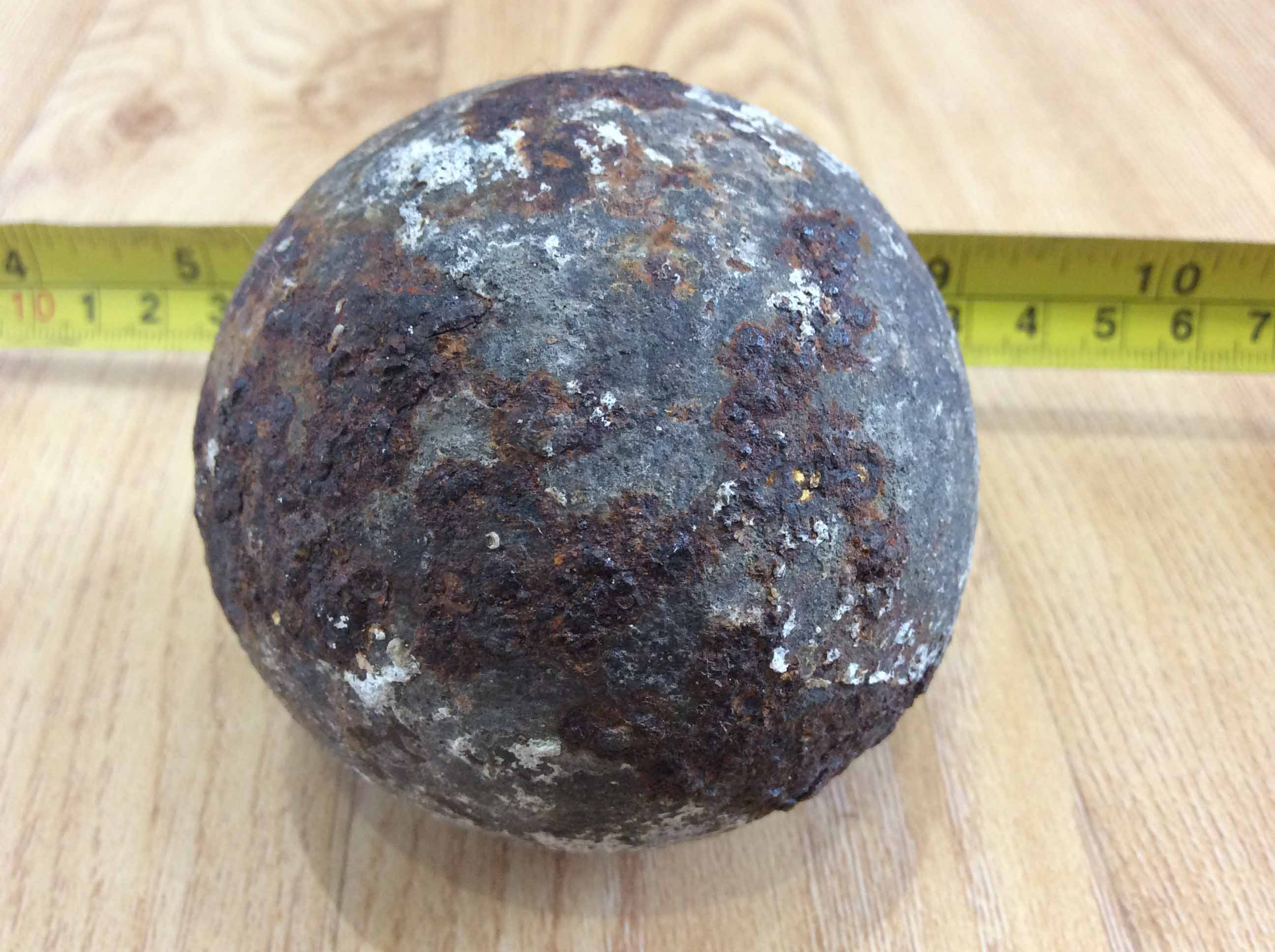
Much of Lyme was flattened.
Sherborne House, already then perhaps two centuries old, must have
taken cannonballs through its walls and firebrands through its thatched
roof. Yet it survived Prince Maurice's bombardment, as it has survived
all vicissitudes since.
A circular tour of Lyme
Sherborne House is a good starting-point for such a tour, which explores as many of the delights of the town as can be strung on one route.
From the front door, the cinema and a pub are opposite; only a few yards farther is the gate into the gardens that overlook the sea, or in another direction the library, and almost next door on the left are the post office, with a café-restaurant hidden behind it, and the grocery shop.
But go around the
corner on the right and down Sherborne Lane. It gets even narrower
and steeper toward the bottom, hits a parapet overlooking the river,
and bends left along the bank, to a small plaza that has the feeling
of being the centre of the old town (and is called that on some
of the signposts pointing the way to it), though really it was the
old town's inland edge.
Mill Green, the lane ahead, is the one that goes inland along the river; or, crossing the bridge at the right, you could go along Coombe Street; but, instead of either of these, turn more sharply right down a step onto the lynchway. This is a narrow causeway between the leet or raised channel and the river in its trench fifteen feet lower. The cliff-like houses that descend the right bank are at the foot of what may once have been Sherborne House's territory. Across the leet (on which families of ducks swim) are tiny bridges to people's gardens; and a footbridge spans the river to a ledge of lawn beside a grotto called Leper's Well. The lynch path twists down past the place where the leet feeds into the mill — which may be in operation, the huge old wheel rumbling inside — and comes into the space among the mill buildings, which include art galleries and a restaurant. (A guided tour of the mill is extremely interesting. And by the way there is a side route up steps from here to an alley called Drake's Way and thus back into Broad Street.) The river wraps in sharp curves around all this (the mill race emerging into it from somewhere under your feet) and disappears under the next cluster of old buildings.
The short Mill Lane comes up into Coombe Street. Go almost straight across it and on up the short Monmouth Street, with a triangular green on the right and, up ahead, the tower of St. Michael's, the Lyme parish church.
As you come up to Church Street, full (unless you're very early in the morning) with traffic pouring into Lyme, bend your way more steeply upward to the left, into the church's gate and the path that climbs along its left side. The churchyard slopes up to a cliff top. The breaking into view of the sky up ahead, then the shining bay, is thrilling at any time of day, but most at sunrise. The cliffs and summits stretch away — Black Ven, Stonebarrow, Langdon, the famous Golden Cap, and others dimming to a glimpse, on some days, of the Isle of Portland (really a peninsula) on the horizon.
From the churchyard's sharp corner, descend one or other of the zigzag paths to the point below, with jetty, informational signs about the geology and wildlife, and danger signs about proceeding on along the beach unless the tide is well out. These cliffs are in retreat, continually exposing the fossils for which Lyme is famous. The lane behind you (Long Entry) once connected to Charmouth but fell away in the 1920s. To the right you may see long trains of combers (breaking waves) rolling in through what is evidently shallow water; low tide exposes a rock platform called Broad Ledge. The town once extended out there! Immediately below you is fascinating detail in the mixture of seaweed, ripple-marked sand, rock pavements, and scattered boulders on which maybe cormorants perch.
Go back along the sea front through a sort of extended castle, built in the 1990s to defend the town against the sea. Several sets of steps lead down to the sea and, on the other side, climb twistily to the Marine Theatre, Guildhall, and the cramped but fascinating museum.
Just after crossing the narrow mouth of the Lim (in whose walls the local flock of pigeons nests) you come to the town's focal point, where the valley meets the sea. The space is now used for nothing more than a parking circle, with clock in the middle; historically it was the site of the Assembly Rooms, and before that of the custom house where goods from the harbour entered the town, which is the reason why the place is called Cobb Gate. The famous Cobb itself, visible ahead, is the high breakwater protecting the harbour, more than half a mile to the west.
Go on along the Marine Parade, by either of its levels: the upper footpath (known in earlier times as The Walk) or the lower roadway, called the Cart Road because of its former function. One of the features you may notice is Lucy's Ledge: this island of seaweedy rocks emerges as the tide goes down.
You could go all the way to the harbour, and walk out along the Cobb itself. Then you could return up the steep Cobb Road; but less arduous is to go a little way back along the front and up into the gardens. The hillside is by nature an extension of the unstable and jungly Undercliff; the few dwellings that were rashly placed there fell victim to landslips. Only in the last three centuries did a skin of buildings grow along the foot of the slope, starting at the Cobb Gate end, and now including ice cream shops, cottages of various periods, the Bay Hotel, and the Shelters, monumentally rebuilt in 2011. The slope itself is covered by extensive gardens, which were reconstructed in 2006 as part of the ongoing coastal protection scheme.
There are many routes up the hillside, but here's a suggestion: keep to the leftmost, going first up steep steps through a small set of terraces that form the Jane Austen Garden. From the top of that you emerge into a wide grassy hillside, which often serves as a grandstand for crowds watching events around the harbour or out on the bay. This is the Lister Garden, and is crossed by various sloping paths. Keep up the left side, so that you arrive between a celebrity-chef restaurant and a miniature golf course. Then turn right along a gravel path, called the Woodland Walk. It is surprising to think that — though you now seem outside the town — this path leads almost to the front door from which you started.
The path skirts along the top of Lister Garden, under a belt of woods. The woods project in a small headland, and the path as it passes through this is raised on a boardwalk. From here open some of the most striking views of Lyme: down over the harbour through an opening in the trees, and then ahead to the town and the bay. On the other side of the wooded headland you emerge into Langmoor Garden, more densely set with flowerbeds, bushy plantings, and many small lawns among them. The gravel path crosses the top of this garden to merge with one of its paths. You round a corner under the high hedge of the Alexandra Hotel, and emerge through a gateway into the town. And there, a few yards down, is Sherborne House.
This highly varied tour takes in most, though not all, of the attractions of Lyme.
BACK
|






 This is a plain
latched wooden door beside the landing, next to a white surface
that rises over the stairway in a smoothly twisted curve. The surface
envelops the underside of nine pinewood steps that spiral tightly
to the attic. They would not be able to do so but that a space has
been made for them by adding a dormer window in the roof.
This is a plain
latched wooden door beside the landing, next to a white surface
that rises over the stairway in a smoothly twisted curve. The surface
envelops the underside of nine pinewood steps that spiral tightly
to the attic. They would not be able to do so but that a space has
been made for them by adding a dormer window in the roof.